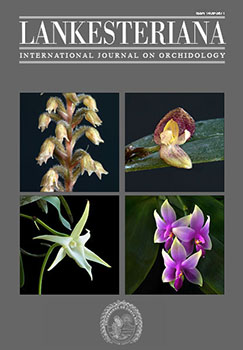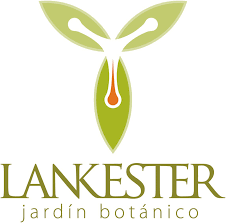<i>Restrepia restrepoi</i>: a new species from the cloud forests of the Colombian Western Andes
DOI:
https://doi.org/10.15517/lank.v25i1.63853Palabras clave:
Dapa, especies endémicas, Orchidaceae, Pleurothallidiinae, Restrepia aberrans, Restrepia chrysoglossa, Restrepia flosculata, taxonomíaResumen
Se describe e ilustra una nueva especie de Restrepia del departamento del Valle del Cauca, restringida al bosque montano lluvioso de los Andes Occidentales de Colombia. La nueva especie es morfológicamente similar a Restrepia chrysoglossa, otra especie restringida al Valle del Cauca; sin embargo, puede distinguirse por sus vainas con manchas marrones, sus flores cleistógamas que no abren completamente, su sépalo dorsal oblongo, atenuado y no claviforme, y su labelo ovado y piriforme cuando está expandido. Se discuten las especies morfológicamente similares y se proporcionan notas sobre su estado de conservación y ecología, destacando su distribución restringida y las posibles amenazas a su hábitat, así como un mapa de distribución.
Descargas
Citas
BGCI. (2023). ThreatSearch online database. Botanic Gardens Conservation International. Richmond, UK. www.bgci.org/threat_search.php.
Calderón-Sáenz, E. (Ed.). (2007). Libro Rojo de Plantas de Colombia. Volumen 6: Orquídeas, Primera Parte. Instituto Alexander von Humboldt – Ministerio de Ambiente, Vivienda y Desarrollo Territorial.
Christmann, T., Palomeque, X., Armenteras, D., Wilson, S. J., Malhi, Y., & Oliveras Menor, I. (2023). Disrupted montane forest recovery hinders biodiversity conservation in the tropical Andes. Global Ecology and Biogeography, 32(5), 793–808. https://doi.org/10.1111/geb.13666
Chumová, Z., Záveská, E., Hloušková, P., Ponert, J., Schmidt, P.-A., Čertner, M., Mandáková, T., & Trávníček, P. (2021), Repeat proliferation and partial endoreplication jointly shape the patterns of genome size evolution in orchids. Plant J, 107, 511–524. https://doi.org/10.1111/tpj.15306
Epidendra. (2025). The Global Orchid Taxonomic Network. Retrieved from http://www.epidendra.com [Accessed 12 January 2025].
Fernández, M., Bogarín, D., Karremans, A. P., & Jiménez, D. (2014). New species and records of Orchidaceae from Costa Rica. III. Lankesteriana, 13(3), 259–282. https://doi.org/10.15517/lank.v13i3.14363
Gutiérrez Morales, N. G., Moreno, J. S., Karremans, A. P., & Gil-Amaya, K. (2023). Restrepia santanderensis (Orchidaceae: Pleurothallidinae), a new species from the western slope of the eastern Andes in Colombia. Phytotaxa, 598(4), 293–300. https://doi.org/10.11646/phytotaxa.598.4.3
Holdridge, L. (1987). Ecología basada en zonas de vida. San José, Costa Rica: IICA.
IPNI. (2025). International Plant Names Index. The Royal Botanic Gardens, Kew, Harvard University Herbaria & Libraries and Australian National Herbarium. Retrieved from http://www.ipni.org (Accessed 12 January 2025).
IUCN. (2020). The IUCN Red List of threatened species v. 2019-3.
Karremans, A. P. (2016). Genera Pleurothallidinarum: an updated phylogenetic overview of Pleurothallidinae. Lankesteriana, 16, 219–241. https://doi.org/10.15517/lank.v16i2.26008
Karremans, A. P., Moreno, J. S., Gil-Amaya, K., Gutiérrez Morales, N., Espinosa, F., Mesa, S., Restrepo, E., Rincón-González, M., Serna, A., Sierra-Ariza, M., & Vieira-Uribe, S. (2023). Colombian Orchidaceae: a catalogue of the Pleurothallidinae. Lankesteriana, 23(2), 181–400. https://doi.org/10.15517/lank.v23i2.56158
Luer, C.A. (1996). Icones Pleurothallidinarum XIII. Systematics of the genus Restrepia (Orchidaceae). Monographs in Systematic Botany from the Missouri Botanical Garden, 59, 1–168.
Luer, C. A., & Thoerle, L. (2012). Icones Pleurothallidinarum XXXII. Lepanthes of Colombia (Orchidaceae). Monographs in Systematic Botany from the Missouri Botanical Garden, 123, 1–300.
Ortiz V., P., Pérez-Escobar, O. A., & Parra-Sánchez, E. (2011). Una nueva y peculiar especie de Lepanthes (Orchidaceae) de Colombia. Orquideología, 28, 22–26.
Ospina-Calderón, N. H., Tremblay, R. L., Torres, A. M., & Flanagan, N. S. (2023). The effect of habitat transformation on a twig epiphytic orchid: Evidence from population dynamics. Frontiers in Ecology and Evolution, 11, 1–12. https://doi.org/10.3389/fevo.2023.1135316
Parra Sánchez, E., Armenteras, D., & Retana, J. (2016). Edge Influence on Diversity of Orchids in Andean Cloud Forests. Forests, 7, 63. https://doi.org/10.3390/f7030063
Parra-Sánchez, E., Pérez-Escobar, O. A., & Edwards, D. P. (2023). Neutral-based processes overrule niche-based processes in shaping tropical montane orchid communities across spatial scales. Journal of Ecology, 111(8), 1614–1628. https://doi.org/10.1111/1365-2745.14140
Pérez‐Escobar, O. A., Chomicki, G., Condamine, F. L., Karremans, A. P., Bogarín, D., Matzke, N. J., ... & Antonelli, A. (2017). Recent origin and rapid speciation of Neotropical orchids in the world's richest plant biodiversity hotspot. New Phytologist, 215(2), 891–905. https://doi.org/10.1111/nph.14629
Pérez-Escobar, O. A., Zizka, A., Bermúdez, M. A., Meseguer, A. S., Condamine, F. L., Hoorn, C., ... & Chomicki, G. (2022). The Andes through time: evolution and distribution of Andean floras. Trends in Plant Science, 27(4), 364–378. https://doi.org/10.1016/j.tplants.2021.09.010
QGIS. (2021). QGIS Geographic Information System. QGIS Association. Retrieved from QGIS.org
Rabinowitz, D. (1981). Seven forms of rarity. In H. Synge (Ed.), The Biological Aspects of Rare Plants Conservation (pp. 205–217). John Wiley & Sons Ltd.
Reina-Rodríguez, G. A., López-Machado, F., & Martel, C. (2019). Telipogon mayoi (Orchidaceae), a new species from the Western Andes of Colombia. Lankesteriana, 19(3), 263–270. https://doi.org/10.15517/lank.v19i3.39969
Reina-Rodríguez, G. A., Ormerod, P., Rubiano-Hurtado, M., & Rubiano-Mejia, J.E. (2022). Two New Species of Crossoglossa (Orchidaceae, Malaxideae) from the Western Andes of Colombia. Harvard Papers in Botany, 27(1), 101–105. https://doi.org/10.3100/hpib.v27iss1.2022.n13
Rodríguez Eraso, N., Armenteras-Pascual, D., & Alumbreros, J. R. (2013). Land use and land cover change in the Colombian Andes: Dynamics and future scenarios. Journal of Land Use Science, 8(2), 154–174. https://doi.org/10.1080/1747423X.2011.650228
Rojas-Alvarado, G., & Karremans, A. (2024). A typological and morphological analysis of the Pleurothallidinae (Orchidaceae) inflorescences. The Botanical Review, 90, 221–250. https://doi.org/10.1007/s12229-024-09303-6
Tadono, T., Ishida, H., Oda, F., Naito, S., Minakawa, K., & Iwamoto, H. (2014). Precise Global DEM Generation by ALOS PRISM. ISPRS Annals of the Photogrammetry, Remote Sensing and Spatial Information Sciences, II-4, 71–76. https://doi.org/10.5194/isprsannals-II-4-71-2014
Thiers, B. (2024). Index Herbariorum: A global directory of public herbaria and associated staff [continuously updated]. New York Botanic Garden’s Virtual Herbarium. Retrieved from http://sweetgum.nybg.org/science/ih [Accessed XX, XX, XXXX]
Tropicos. (2025). Retrieved from http://www.tropicos.org [Accessed 12 January 2025].
Vogel, S. (1990). The role of scent glands in pollination: on the structure and function of osmophores. Washington, D.C.: Smithsonian Institution Libraries and The National Science Foundation.
Zepner, L., Karrasch, P., Wiemann, F., & Bernard, L. (2020). ClimateCharts.net – an interactive climate analysis web platform, International Journal of Digital Earth, 14(3), 338–356. https://doi.org/10.1080/17538947.2020.1829112

Descargas
Publicado
Cómo citar
Número
Sección
Licencia
Derechos de autor 2025 Lankesteriana: International Journal on Orchidology

Esta obra está bajo una licencia internacional Creative Commons Reconocimiento-NoComercial-SinObraDerivada 3.0.
Conforme con las Políticas de Acceso Abierto promovidas por la Universidad de Costa Rica, los derechos de autor de todos los artículos publicados en Lankesteriana se encuentran bajo una licencia Creative Commons y pueden ser descargados gratuitamente. Los derechos de autor y de publicación pertenecen a la revista bajo la licencia CC BY-NC-ND 3.0 CR.
Before the publication of the materials submitted by the author(s) in LANKESTERIANA, the author(s) hereby assign all rights in the article to the Lankester Botanical Garden.




